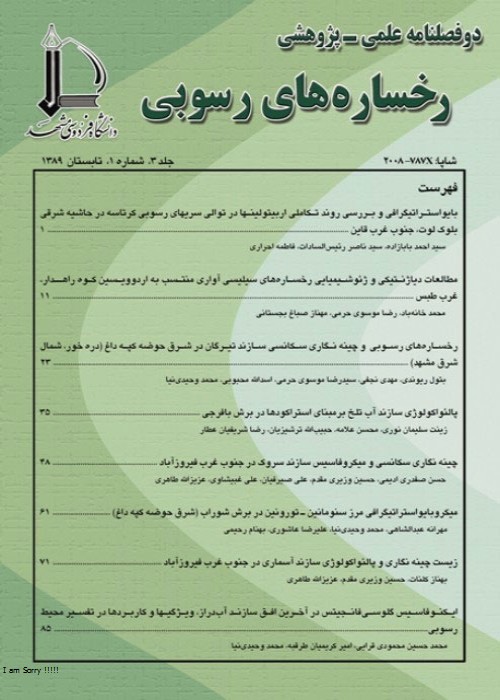Biostratigraphy, microfacies and depositional environment of Asmari Formation in one of the Marun oil field wells and comparison with other Zagros area
This study was aimed at the biostratigraphy and sedimentary environments reconstruction in one of the wells in Maroun oilfield at Dezful embayment zone. We also compared the studied sub-surface section with the equal intervals in Mala-Kuh, Ghale-Nar oilfield, Moshkan section, and Firouzabad section. The thickness of Asmari Formation in the studied well is 370.5 m and consists mainly of limestone, dolomite, dolomitic limestone, sandstone and argillaceous limestone. In this well, the lower boundary of the Asmari Formation with Pabdeh Formation and its upper boundary with Gachsaran Formation is continuous.
For this study, 150 thin sections (mainly drilled cores) were studied in detail for paleontology, biostratigraphy, allochems identification, and microfacies determination. References such as Loeblich and Tappan (1980), Boudagher-Fadel, (2008), Adams & Bourgeois (1967), and other related articles were used to identify the available microfossils. We used the biozonation scheme of Laursen et al. (2009) and Van Buchem et al. (2010) to define and correlate the biozones. Classification of rock types was done according to Dunham (1962) and Embry & Klovan (1971), and microfacies identification and interpretation were carried out based on Wilson (1975), Buxton & Pedley (1989), Geel (2000), and Flugel (2010),
Based on paleontological studies, 43 genera and 61 species of benthic and planktonic foraminifera were identified. They have been classified into six zones (five assemblage zones and one indeterminate zone) as follows:1- Globigerina spp.-Turborotalia cerroazulensis-Hantkenina Assemblage ZoneThis biozone is 76 meters thick and lies between the depths of 3706.5 to 3630.5 m. It corresponds to the upper part of the Pabdeh Formation. In this biozone with Oligocene (Rupelian) age, Globigerina spp. are abundant, and the extinction of Turborotalia cerroazulensis occurs in this biozone.2- Lepidocyclina-Operculina-Ditrupa Assemblage ZoneThis biozone is 129.5 meters thick and lies between 3630.5 to 3501 m. The beginning of this biozone is based on the first occurrence of the Lepidocyclina sp. and Operculina complanata. Its end is marked by the first appearance of the Miogypsinoides compalanatus and Spiroclypeous blankenhorni. This biozone belongs to the Chattian-Rupellian age.3- Archaias asmaricus-Archaias hensoni-Miogypsinoides compalanatus Assemblage ZoneThe thickness of this biozone is 80 meters and lies between 3501 to 3421 meters deep. The onset of this biozone is marked by the first occurrence of Miogypsinoides compalanatus and Spiroclypeous blankenhorni. The first occurrence of Elphidium sp.14, Peneroplis farsensis and disappearance of Archaias distinguish the end of the biozone. The age of this biozone is Chattian.4- Elphidium sp.14 – Peneroplis farsensis Assemblage ZoneThis Assemblage zone is 83 meters thick and lies between 3421 to 3338 meters deep. The age of this biozone is Aquitanian. The onset of this biozone is determined by the occurrence of the Elphidium sp.14, Peneroplis farsensis, and the end of this biozone is characterized by a decrease in the fossil fauna assemblage known as the Ambiguous Zone.5-Indeterminate ZoneWith 70.44 meters thickness, this zone lies between the depths of 3338 to 3267.57 meters. A decrease in fossil assemblages characterizes this interval. According to its stratigraphic locality, this indeterminate zone is related to Aquitanian (Laursen et al., 2009). The fossils present in this biozone are very sparse and consist mainly of porcelaneous and indeterminate milliolids.6- Borelis melo curdica-Borelis melo melo Assemblage Zone?This biozone is related to the uppermost part of the Asmari Formation. The beginning of this biozone is defined based on the occurrence of the Borelis spp., continues to the end of the Asmari Formation. This biozone is 7.56 meters thick and lies between 3267.56 to 3260 meters deep. The age of this biozone is cautiously Burdigalian.Based on the mentioned biozones, the age of Asmari Formation in the studied well is Rupelian – Chattian –?Burdigalian.According to sedimentary texture, sedimentary structures, skeletal and non-skeletal elements in the microscopic studies if the provided thin section, 12 microfacies related to the outer ramp, middle ramp (distal and proximal parts), shoal and inner ramp environments (patch reef, lagoon (semi-restricted and restricted( and tidal flat were identified in the studied well. Gradual changes of facies to each other, the lack of coated structures, and the absence of coated grains are the main evidence suggesting deposition in a homoclinic carbonate ramp. Microfacies analysis shows that planktonic foraminifera in the upper part of the Pabdeh Formation belongs to the outer ramp. Due to the presence of large hyaline foraminifera, the lower part of the Asmari Formation is deposited in the distal part of the middle ramp, while the presence of lenticular foraminifera demonstrates the proximal ramp environment. A high-energy, shallow-shoal environment with the presence of thick-walled lenticular foraminifera, cementation, and grainstone textures characterize the boundary between the middle and the inner ramp. Inner ramp environment is considered by the presence of patchy corals (patch reef) and imperforate foraminifera (Archaias, Peneroplis, milliolids) of the lagoon (semi-restricted and restricted lagoon) and tidal flat zones.


